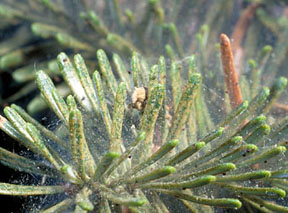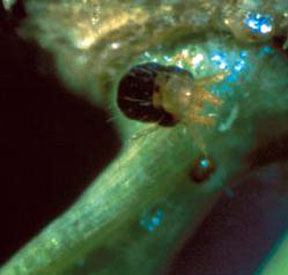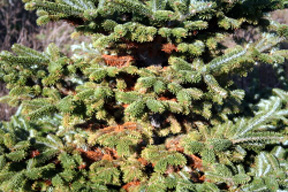Spruce spider mites
Editor’s note: This article is from the archives of the MSU Crop Advisory Team
Alerts. Check the label of any pesticide referenced to ensure your use is
included.
Spruce
spider mites are often a problem on fir and spruce trees, but
populations can build up on nearly all Christmas tree species. Spruce
spider mites are considered a cool season mite and thrive when daytime
temperatures are in the 60’s and 70’s. We have found mite activity on
Fraser and balsam fir. Newly hatched larvae are pinkish in color, but
turn dark green or dark red after initial feeding. Growers should keep
an eye out for the dark mites or their webbing, especially if you had
damage from mites last year. These mites are small, about the size of a
period at the end of a sentence. Scout the oldest foliage, near the stem
of the tree – that’s where the mite populations build up first. Rap
foliage over white paper or cardboard on a clipboard. If mites are
there, you should see them moving on the paper. If you see a few mites,
but damage does not appear to be heavy, give it another seven to ten
days and check the trees again. There are several naturally occurring
predators that feed on spider mites and you want to give them a chance
to do their thing. Predatory mites are the most important predators of
spider mites, but are very difficult to see without a microscope. If you
check the trees and mites seem to be abundant, especially if you plan
to sell trees this year, then you may want to apply a miticide. If you
are spraying Christmas trees for spider mites, do everything you can to
get good coverage.
Here is an excellent reference from Pennsylvania on spruce spider mite by Rayanne Lehman http://ento.psu.edu/extension/christmas-trees/information/pest-fact-sheets/Spspidermiteent069.pdf/view



 Print
Print Email
Email







